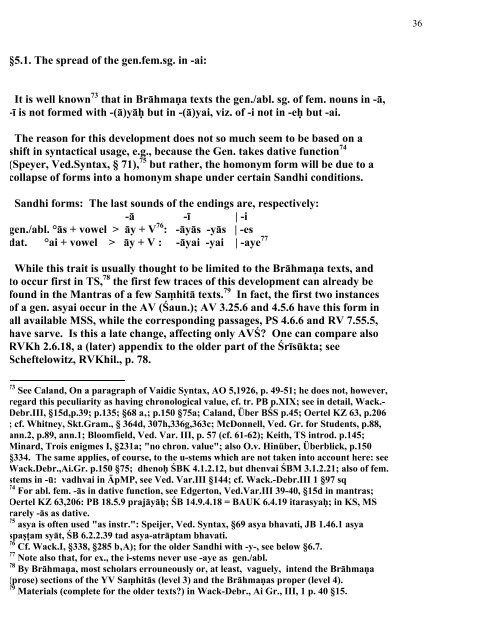TRACING VEDIC DIALECTS - People.fas.harvard.edu
TRACING VEDIC DIALECTS - People.fas.harvard.edu
TRACING VEDIC DIALECTS - People.fas.harvard.edu
You also want an ePaper? Increase the reach of your titles
YUMPU automatically turns print PDFs into web optimized ePapers that Google loves.
§5.1. The spread of the gen.fem.sg. in -ai:<br />
It is well known 73 that in Brāhmaṇa texts the gen./abl. sg. of fem. nouns in -ā,<br />
-ī is not formed with -(ā)yāḥ but in -(ā)yai, viz. of -i not in -eḥ but -ai.<br />
The reason for this development does not so much seem to be based on a<br />
shift in syntactical usage, e.g., because the Gen. takes dative function 74<br />
(Speyer, Ved.Syntax, § 71), 75 but rather, the homonym form will be due to a<br />
collapse of forms into a homonym shape under certain Sandhi conditions.<br />
Sandhi forms: The last sounds of the endings are, respectively:<br />
-ā -ī | -i<br />
gen./abl. °ās + vowel > āy + V 76 : -āyās -yās | -es<br />
dat. °ai + vowel > āy + V : -āyai -yai | -aye 77<br />
While this trait is usually thought to be limited to the Brāhmaṇa texts, and<br />
to occur first in TS, 78 the first few traces of this development can already be<br />
found in the Mantras of a few Saṃhitā texts. 79 In fact, the first two instances<br />
of a gen. asyai occur in the AV (Śaun.); AV 3.25.6 and 4.5.6 have this form in<br />
all available MSS, while the corresponding passages, PS 4.6.6 and RV 7.55.5,<br />
have sarve. Is this a late change, affecting only AVŚ? One can compare also<br />
RVKh 2.6.18, a (later) appendix to the older part of the Śrīsūkta; see<br />
Scheftelowitz, RVKhil., p. 78.<br />
73 See Caland, On a paragraph of Vaidic Syntax, AO 5,1926, p. 49-51; he does not, however,<br />
regard this peculiarity as having chronological value, cf. tr. PB p.XIX; see in detail, Wack.-<br />
Debr.III, §15d,p.39; p.135; §68 a‚; p.150 §75a; Caland, Über BŚS p.45; Oertel KZ 63, p.206<br />
; cf. Whitney, Skt.Gram., § 364d, 307h,336g,363c; McDonnell, Ved. Gr. for Students, p.88,<br />
ann.2, p.89, ann.1; Bloomfield, Ved. Var. III, p. 57 (cf. 61-62); Keith, TS introd. p.145;<br />
Minard, Trois enigmes I, §231a; "no chron. value"; also O.v. Hinüber, Überblick, p.150<br />
§334. The same applies, of course, to the u-stems which are not taken into account here: see<br />
Wack.Debr.,Ai.Gr. p.150 §75; dhenoḥ ŚBK 4.1.2.12, but dhenvai ŚBM 3.1.2.21; also of fem.<br />
stems in -ū: vadhvai in ĀpMP, see Ved. Var.III §144; cf. Wack.-Debr.III 1 §97 sq<br />
74 For abl. fem. -ās in dative function, see Edgerton, Ved.Var.III 39-40, §15d in mantras;<br />
Oertel KZ 63,206: PB 18.5.9 prajāyāḥ; ŚB 14.9.4.18 = BAUK 6.4.19 itarasyaḥ; in KS, MS<br />
rarely -ās as dative.<br />
75 asya is often used "as instr.": Speijer, Ved. Syntax, §69 asya bhavati, JB 1.46.1 asya<br />
spaṣṭam syāt, ŚB 6.2.2.39 tad asya-atrāptam bhavati.<br />
76 Cf. Wack.I, §338, §285 b‚A); for the older Sandhi with -y-, see below §6.7.<br />
77 Note also that, for ex., the i-stems never use -aye as gen./abl.<br />
78 By Brāhmaṇa, most scholars errouneously or, at least, vaguely, intend the Brāhmaṇa<br />
(prose) sections of the YV Saṃhitās (level 3) and the Brāhmaṇas proper (level 4).<br />
79 Materials (complete for the older texts?) in Wack-Debr., Ai Gr., III, 1 p. 40 §15.<br />
36
















